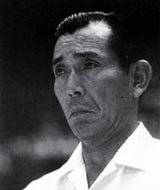田代潤一氏の起案になる剣道具の改良に係る意見書
標記の件
1)面垂先端部の形状改良(刺し線状の改良含む)
2)大垂(左右)先端部の形状改良
3)甲手筒部と手首の縫合部改良
について下記の通り推薦いたします。
剣道範士八段


記
- 剣道はその技能の完成にあたり、対人的攻防技能の優劣を競いあるいは高度化をめざすに留まらず、対人的攻防局面における動作の美しさを追及する運動でもある。また剣道衣、袴の装着及び道具の装着における姿態の美的完成度も併せて追求する文化財である。
従って着用する剣道具は、激しい打突行動から安全に身を護る機能性と同時に、装着時の姿態の美しさを表現するに足りる形状に関する工夫研究も重要な課題である。
今回、田代潤一氏の考案になる、1)面垂先端部及び2)左右大垂先端部の形状改良は、特に姿態美について追求した結果である。即ち伝統的に受け継がれてきた袴の装着習慣(後裾上がりに装着すること)と見事に調和しており、直立して静的に構えた姿の中に、対峙する相手への攻撃を感じさせる姿態の表現を可能にしている。しかもこれは、身体を防護する機能あるいは竹刀操作・体捌きを一切阻害するものではない。 - 左手首は剣道の打撃運動においてもっとも重要かつ微妙な作用が求められる部位である。
竹刀を保持して構えた(中段の構え)際に、あるいは打撃時において、左手首は適度に内側に屈曲(手首を入れる)して手の内の締めを効果的ならしめなければならない。
従って防護具として甲手を装着した際にも、素手による場合と同様の運動が保証されなければならないが、従来品の場合は、相当の期間相当の力量を加えてこれを使いこなさなければ先述のような左手の作用を円滑に実行可能な形状にするには至らなかった。
今回の、3)甲手筒部と手首部の縫合部の改良、によって新品の段階から容易に左手首の内曲運動を可能にし、特に幼少年期や非力な女性の修練者にとっては、素手から甲手装着へ移行する段階で正確に系統的に技能の習慣を可能にする朗報と確信できる。
My view on the Hotaru Bogu
Hanshi 8th Dan Masatake Sumi
In summery I recommend the Hotaru bogu for the following characteristics:
- Innovative angular design in the Men-dare (Men flaps), including the stitching
- Innovative angular in the Tare hems (right and left side flaps).
- The wrist stitching method used in the construction of the Kote.
When learning Kendo the aims are not only to improve and develop the technical aspects of fighting opponents but also to pursue both beauty and elegance through the presence and movement in a combat based environment. The wearing of Kendo-gi, Hakama and Bogu plays a large part in learning the latter. Needless to say, Bogu should be made to protect the body from strikes and thrusts, but it should also be made to appear pleasing, elegant and comfortable, for which research needs to be undertaken and development implemented, in search of the more beautiful forms for those wearers who would desire a more noble presence when confronting an opponent. In the Hotaru bogu designed by Mr Tashiro the Men- dare and Tare flaps left and right are the result of his research into the beauty of design evident in Kendo bogu. This is to say that it made perfect sense as with the traditional wearing of Hakama where the front is lower than the back, (which expresses a sense of attacking with pressure when in the standing position of Kamae, which is namely calm), to mirror this angular design in the Men-dare and side flaps of the Tare. This angular design helps to increase the sense of attacking even more without affecting or altering the use of Shinai or the body movement. The left wrist plays one of the most important roles in Kendo as one is required to control this joint meticulously in order to make the correct striking movements. When in Chudan-no-Kamae with Shinai and poised ready to make a correct strike, this joint is turned slightly inwards, this way one is utilising a correct Tenouchi grip. The subtle turning grip technique is only possible if one has the correct Kote equipment, which can provide the same flexibility to the joint as one would experience without wearing Kote. Traditional Kote often comes with a hard wrist joint therefore wearers need to spend some time to make it flexible before it can be used correctly. The wrist stitching method makes it possible for the wearer to use the Hotaru Kote as if it has been used for some time, and I believe that it is especially beneficial for junior, ladies and beginners for their transition from not wearing amour to wearing amour including Kote, as they will be more comfortable and experience smoother movement during this transition.